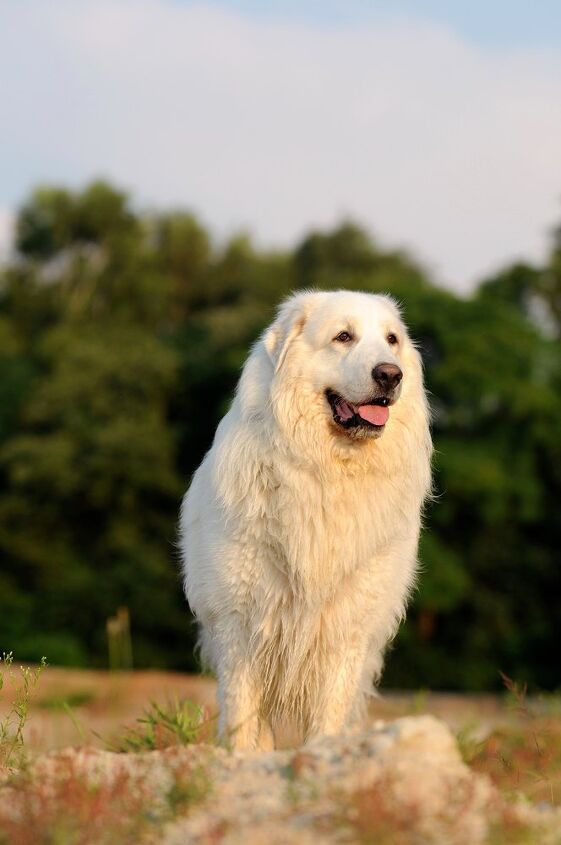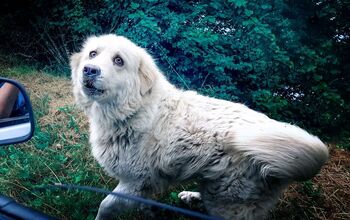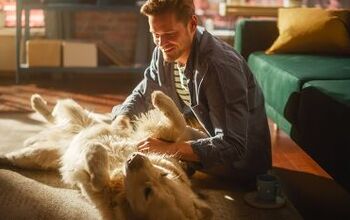Great Pyrenees


About Great Pyrenees
Great Pyrenees (also known as Pyrenean Mountain Dog) is a multi-faceted dog. This breed is well-known for its ability to herd, guard and as a calm companion. If you bring one into your home, you’ll soon find that the Great Pyrenees will be your constant protector, making it an excellent watchdog.
Sporting a beautifully thick, weather resistant white coat, the affectionate Great Pyrenees is a gentle giant that has a way with kids. Quiet and tolerant, this dog is a wonderful playmate for kids of all ages. Read on to find out more about this elegant breed.
If you bring one into your home, you’ll soon find that the Great Pyrenees will be your constant protector, making it an excellent watchdog.
An old breed, the Great Pyrenees was bred as a working dog for by shepherds in and around the Pyrenees Mountains of southern France and northern Spain. This breed was used to guard sheep on steep mountainous slopes. One of the first descriptions of the breed dates back to 1407, and this dog was even a favorite of The Grand Dauphin and other members of the French aristocracy in the late 1600s.
There are two sub-categories of this breed – the Western and the Eastern. The Great Pyrenees are related to several other large white European livestock guardian dogs, including the Italian Maremma Sheepdog, Kuvasz (Hungary), Akbash Dog (Turkey) and Polish Tatra or Polski Owczarek Podhalański. It is also related to the Newfoundland and St. Bernard.
The Great Pyrenees was recognized by the AKC in 1933.
For a large dog, the Great Pyrenees has a moderate appetite. In fact, you’ll find that feeding your pooch is no different than most other dogs. Feed your dog a well-balanced and quality dog food with quality ingredients, which will help develop and maintain good health and a shiny coat.
Sporting a beautifully thick, weather resistant white coat, the affectionate Great Pyrenees is a gentle giant that has a way with kids.
When training Great Pyrenees, it’s important to note that this breed prefers to be treated as an equal. This means that it will be more responsive to training if it is allowed to be involved in the process rather than being told what to do. This is an intelligent dog, so don’t try to outsmart it – it could result in a stubborn dog.
You want a dog that listens and is well behaved, and training will go a long way in providing that. You may find that the Great Pyrenees’ large size and independent streak can make training stressful, but with the right approach, it will be an easier process to train your Great Pyrenees.
Male Great Pyrenees weigh 100 to 115 pounds, while females weigh 85 to 95 pounds.
Bred to be smart and hardworking, the Great Pyrenees can be quite independent. The breed is also described as being affectionate, devoted and very protective.
Boasting a whole lot of spunk, the Great Pyrenees may not like to follow orders at all times. You must always present a dominant front in order for your dog to obey you. Always remember to work together with your dog as a team – you’ll find that this method gets you the best results.
Thanks to its herding and protective instincts, the Great Pyrenees is good with children. You can count on this breed to keep a watchful eye on the kids in your family. However, the breed may not feel the same about children it doesn’t know, so in these circumstances, this dog should be supervised. Even though the Great Pyrenees is a calm dog, children should be taught not to mess with the dogs ears and loud noises should be kept to a minimum.
You’ll know if your Great Pyrenees is showing you some love if it leans or lays on you. It loves to cuddle when sleeping, so you may have some issues keeping it off the bed. It’s not an aggressive breed, but if you’re too controlling, it could lead to resistant behavior. As your dog gets older, odd behaviors may present themselves. This could mean that your dog is less tolerant of strangers and not as affectionate as it once was.
The only health problems the Great Pyrenees suffers from are a result of its size. Genetic disorders are rare, as most breeding done carefully. Problems you should be aware of include bloat, joint problems and deafness.
Great Pyrenees have a life expectancy of 10 to 15 years.
Because this breed is used to being able to roam about freely and constantly being on the go, the Great Pyrenees will be happiest if it gets a lot of daily exercise. If you leave your dog alone, it will just run around happily all day. When taking your dog for a walk or run, be sure to keep it on a strong lease, or else it may try to make a break for it.
Bred to be smart and hardworking, the Great Pyrenees can be quite independent.
The American Kennel Club says this about the breed: “Despite his regal and majestic appearance, the Great Pyrenees is a keen worker, faithfully guarding his flocks no matter the weather or terrain. With his intelligence, scenting ability and excellent sight, he is an invaluable companion to the shepherd.”
One of the things that makes the Great Pyrenees really stand out, its white, thick, woolly coat offers protection from the elements. Since it is so fluffy, the fur is quite repellent. You’ll notice that it sheds often, which help keeps the dog clean.
Even though its coat is fluffy, it should never be shaved off. It will shed during the year, so you’ll need to brush often – one or more times per week. Due to the excessive shedding, the Great Pyrenees stays clean and doesn’t require much bathing.
A cute little snowball of fur, Great Pyrenees puppies are hard to resist. Proper training begins the moment you bring them home – you want to establish your dominance as early as possible.
Photo credit: Schubbel/Shutterstock

Amy Tokic, Editor of PetGuide.com, is a passionate animal lover and proud pet parent of Oscar, a Shih Tzu/Chihuahua cross, and Zed, a Japanese Chin. Her love of animals began in kindergarten, when she brought her stuffed dog Snoopy into class with her every day. Now, she writes about her adventures in pet ownership and tirelessly researches products, news and health related issues she can share with other animal enthusiasts. In her free time, Amy loves perusing used book and record stores, obsessing over the latest pet products available and chasing squirrels with wild abandon (a habit attributed to spending too much time with her pooches).
More by Amy Tokic

























